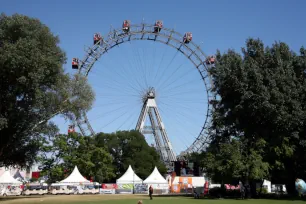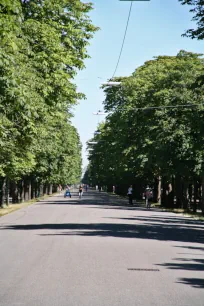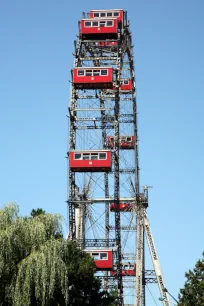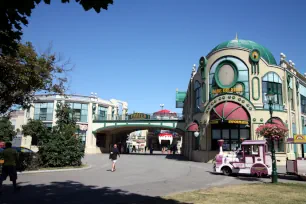Prater is a large recreational tract of parkland situated between the Danube River and the Danube Canal, just east of Vienna’s historic center. The most famous attraction is the Riesenrad, a historic giant wheel.

Besides large swaths of green space with meadows and mixed woodland, Prater includes recreational facilities such as tennis courts, a large stadium, racecourses, a swimming pool and a planetarium as well as a trade fair center.
The biggest attractions of Prater can be found in the northwestern part, where visitors will find an amusement park and the famous giant wheel. The area is especially popular during weekends, when Viennese come here for a stroll in the park or to visit one of the attractions.



History
Prater was originally a hunting ground along the Danube River only accessible to aristocrats. In 1766 Emperor Joseph II opened the park to the people of Vienna, who soon came here en masse for a picknick or a stroll through the woods. During weekends, the Hauptallee, the main thoroughfare, was the place to be seen.
Soon a number of entertainment attractions were set up in the northwestern part of Prater, including as a carousel, a shooting gallery and a circus. The attractions would eventually lead to the creation of the Wurstelprater, an amusement park.
In 1873, Prater played host to a World Trade Fair, which was held mainly at the Rotunda, a large circular exhibition hall. The Rotunda, with its tall cupola and diameter of 108 meters (350 ft.), was long a famous landmark in Vienna until it burned down in 1938.
Riesenrad
The most famous attraction at Prater is the Riesenrad (giant wheel), part of an amusement park known as Volksprater or Wurstelprater. It was erected in 1896-1897 by the British engineer Walter Basset. It is the only surviving example of a series of giant wheels Basset erected; others in cities like Paris and London were dismantled long ago.
The Riesenrad became famous partly due to its appearance in the classic 1949 film ‘The Third Man’ where Orson Welles takes a ride on the giant wheel. The enormous wheel turns at a speed of just 75 cm per second (30″). From a height of about 64 meter (210 ft.) you have a great view over Prater.
Wurstelprater
The Riesenrad is part of a historic fun-fair, the Wurstelprater, also referred to as Volksprater. It offers a variety of roller coasters, merry-go-rounds, ghost trains, bumper cars and other attractions.


Today’s Wurstelprater is a modernized version of an older amusement park which burned down in 1945, at the end of the Second World War. A small museum at Prater, the Pratermuseum, recounts the magic of the Alte Wurstelprater with photos, paintings, billboards and even old slot-machines.
Grüner Prater
The heart of Prater is formed by the six hundred hectares (1,500 acres) large Grüner Prater, a nature park with woodland, ponds, streams and meadows.
The Hauptallee, a 4.7-km-long / 3-mile-long avenue lined with chestnut trees, cuts through the park and leads from the Riesenrad southeast towards the Lusthaus, an eighteenth-century pavilion originally built as a hunting lodge, but today home to a restaurant.
People enjoy walking or biking through Prater, but one alternative is a miniature railway, the Liliputbahn, which makes a four km. tour along the Hauptallee with three stops: Praterstern near the Riesenrad, Rotunda in the middle, and Stadion near the large football stadion, which is situated halfway towards the Lusthaus.
- Next: Volksgarten
- More Sights & Attractions in Vienna

